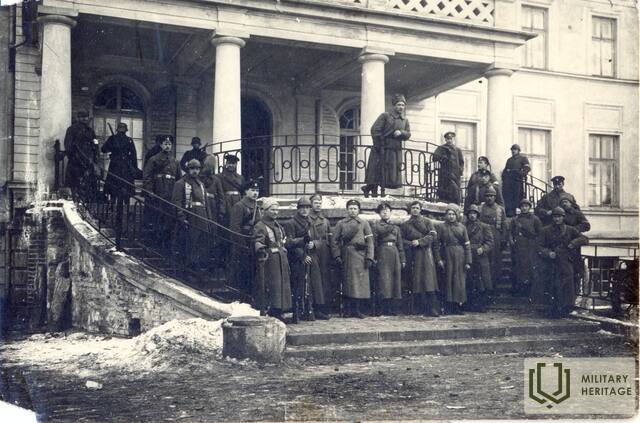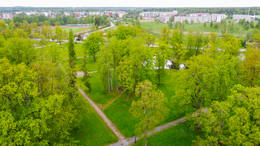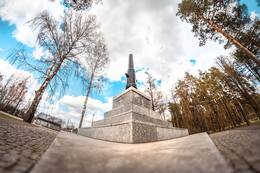pulkas
Baltijos šalių nepriklausomybė, I WW1, I Nepriklausomybės karai
Pulkas (latv. pulks, vok. Regiment) – tai karinis vienetas Europos karinėje tradicijoje, įskaitant Latvijos armiją.
Tai buvo didžiausias vienos ginklų klasės (pėstininkų, raitųjų pėstininkų ar artilerijos) vienetas, vadovaujamas pulkininko. Taktinėms užduotims atlikti pulkai buvo suskirstyti į batalionus ir kuopas pėstininkams, divizijas ir baterijas artilerijai bei divizijas ir eskadriles raitiesiems pėstininkams.
Susijusi laiko juosta
Susijusios vietos
Latvijos karinės aviacijos oro uostas
Įsikūręs Vecgulbenės dvaro teritorijoje – istoriniame centre.
Tarpukariu Gulbenėje buvo įsikūręs Latvijos armijos garnizonas, kuriame buvo dislokuotas 7-asis Siguldos pėstininkų pulko batalionas. Ketvirtojo dešimtmečio viduryje pradėta kurti karinė aviacijos bazė, nes sėkmingam karinės aviacijos veikimui net taikos metu turi būti užtikrintas platus aerodromų tinklas. Aerodromai ypač svarbūs tose vietose, kur įkurtos svarbios geležinkelio ir kelių sankryžos. 1935 m. lapkričio 11 d. čia pradėtas karinio aerodromo statymas. 1937 m. Gulbenėje buvo dislokuotas naujai suformuotas Aviacijos pulko dalinys, kuris tapo 6-uoju Latgalos divizijos žvalgybos eskadrile, padidindamas armijos dalinių skaičių prie rytinės Latvijos sienos.
Matosi oranžerijos pastatas.
Livani išlaisvinimo paminklas
Paminklas yra Fabriko ir Stacijos gatvių sankryžoje, kur jį 1935 m. birželio 9 d. atidengė generolas Rūdolfas Bangerskis, pagerbdamas 1919 m. Lyvanų išvadavimo mūšiuose žuvusių karių atminimą.
Pagrindinis jo elementas – 15 tonų sveriantis vertikaliai pastatytas patrankos vamzdis. 1958 m. sovietų valdžia išardė Lyvanų laisvės simbolį, supjaustydama jį į metalo laužą. Gyventojai per visus sovietinius metus išsaugojo patrankos sviedinius, o po pusės amžiaus jie grįžo į ankstesnę vietą. Paminklo restauravimo idėja tarp žmonių gyvavo visus šiuos metus. Lyvanų krašto taryba kartu su gyventojais aktyviai dirbo restauruojant paminklą. Iš žmonių buvo renkamos aukos, o 2004 m. spalio 3 d. restauruotas Lyvanų išlaisvinimo paminklas buvo atidengtas istorinėje vietoje miesto parke.
Užrašas ant paminklo: „Jelgavos pėstininkų pulko kariai, žuvę už Latviją prie Lyvanų ir apylinkių išvadavimą 1919 m. Buvusio Šiaurės Latvijos partizanų pulko kariai.“
Toliau pateikiami kareivių ir partizanų vardai.
Netoliese įrengtos atminimo lentos Lyvanų rajono Lačplėsio karo ordino kavalieriams.
Paminklo projekto autorius buvo architektas Pāvils Dreimanis.
1919 m. spalio 3–5 d. Līvānų mūšis
1919 m. spalio 3 d. bolševikai patyrė stiprų smūgį fronte netoli Lyvanų. Lyvanų puolime dalyvavo 3-iojo Jelgavos ir 4-ojo Valmieros pėstininkų pulkų daliniai, taip pat Latvijos vokiečių landesvero (buvusio Landesvero) daliniai. Artilerijos remiami, 3-iojo Jelgavos pėstininkų pulko daliniai persikėlė per Dauguvą. Po sėkmingo persikėlimo prasidėjo visą dieną trukusios Lyvanų kautynės. Apie 17:30 val. buvo užimta Lyvanų stotis, o po valandos – perbraukti tiltai per Dubnos upę. Jungtinės pajėgos sugebėjo išstumti bolševikus iš Lyvanų, ir iki 19:00 val. miestas buvo visiškai išlaisvintas. 1919 m. spalio 5 d. bolševikai bandė atgauti Lyvanus, puldami naujas 3-iojo Jelgavos ir 4-ojo Valmieros pėstininkų pulkų pozicijas. Latviai sunkiai išlaikė užimtas pozicijas. Tai buvo pirmasis rimtas ir sėkmingas išpuolis Rytų fronte nuo 1919 m. liepos iki spalio mėn.
Būdami prie Lyvanų išlaisvinimo paminklo, galite nuskaityti QR kodą ir pasiklausyti garso įrašo apie paminklo istoriją. Pasakojimą taip pat galite rasti „IziTravel“ platformoje ČIA . Pasakojimas prieinamas latvių ir anglų kalbomis.
Susijusi istorija
7. Siguldos pėstininkų pulko formavimas
1919 m. birželio 20 d. Naukšėnų dvare, netoli Rūjienos, Šiaurės Latvijos brigados vado pulkininko Jorgio Zemitano įsakymu pradėtas formuoti 7-asis Siguldos pėstininkų pulkas. Iš pradžių iš Šiaurės Latvijos brigados rezervinio bataliono buvo suformuota nedidelė kovinė grupė, susidedanti iš 22 karininkų ir 1580 kareivių, kuri, pagerbiant pirmąjį vadą Oskarą Dankerį, buvo pavadinta Dankerio divizija. Po kelių dienų divizija buvo įtraukta į 3-iojo Jelgavos pulko 2-ąjį batalioną, o rugpjūčio 23 d., pridėjus kuopą, – į 7-ąjį Siguldos pėstininkų pulką.
Šiaurės Latgalos išlaisvinimas nuo bolševikų
1918 m. gruodžio 1 d. Raudonosios armijos daliniai, sudaryti iš raudonųjų šaulių dalinių, įsiveržė į Latvijos teritoriją. Siekdami apsaugoti savo namus, šeimas, gimtąjį kraštą ir išvengti teroro, Balvių apylinkių vyrai griebėsi ginklų ir patraukė į miškus, prasidėjo pirmųjų „žaliųjų“ grupių formavimasis. 1919 m. pavasarį, paskelbus mobilizaciją, daugelis Balvių apylinkių vyrų laikė nepriimtiną kovą sovietinėje Latvijos armijoje ir prisijungė prie „žaliųjų“ grupių. Buvo suformuotos Balvių, Silakrogo, Rugėjų, Teteru-Dūrupės ir Liepnos grupės. „Žaliųjų“ grupių veikla Balvių apylinkėse suaktyvėjo 1919 m. kovo mėn.









